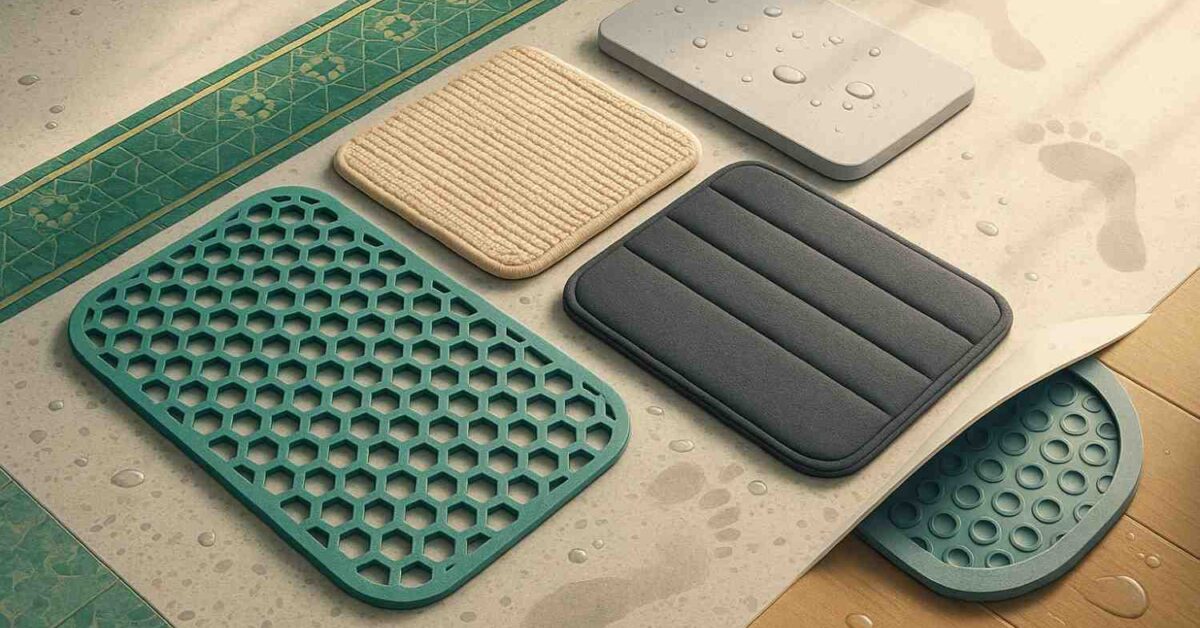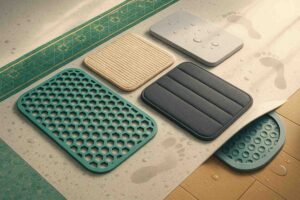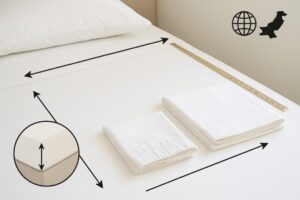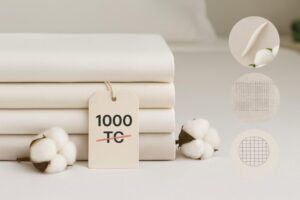If you’ve ever stepped out of the shower onto a tile floor and done the accidental moonwalk, you already know: bath mats are safety gear first, décor second. The right mat grips when wet, dries fast between showers, feels great underfoot and looks like it belongs in your bathroom (not a yoga studio lost its way).
This is a global first guide with Pakistan context baked in. Whether you’re sitting out an apartment in Karachi, furnishing a rental in Dubai, refreshing a family bath in London, or setting up a guest suite in Toronto, you’ll find exactly what to buy and why.
The 5-minute buyer’s map
- Start with safety: Look for non-slip backing (TPR/latex) or grippy waffle rubber. If it skates on wet tile, it’s a no.
- Match material to use:
- Cotton pile: classic, absorbent, easy to wash.
- Microfiber: fast dry, lightweight, good for humid homes.
- Memory foam = cushy comfort, but needs ventilation to dry.
- Pick a sensible weight: Cotton mats shine around 900–1,300 GSM; microfiber achieves the same “dry fast” feel at lower weight.
- Right size, right place: Standard 50×80 cm (20×31 in) works for most showers; larger for tubs and double vanities; smaller for powder rooms.
- Care plan: Mats must fully dry between uses. Machine wash warm, tumble low/medium, no heavy softeners.
- Pin this in your notes and you’ll avoid 90% of regrets.
Backing that grips and survives laundry
- TPR (thermoplastic rubber) or latex backings are the most common non slip solutions. They should feel grippy to the touch but not sticky.
- Molded waffle rubber or rubberized lattices work well for shower exits water can pass through instead of pooling.
Pro tip: Press the mat on wet tile and try a twist with your body weight. If it slides now, it will slide when you aren’t thinking about it. Replace any mat whose backing has cracked, flaked, or gone slick.
Edges that don’t fight you
- Look for bound or framed edges. They lie flat and resist curling, which reduces trip hazards.
- Avoid super light fringe trims in high traffic bathrooms; they tangle and trap lint.
Materials decoded (feel, drying time, and who they suit)
1) Cotton pile
- Feel: Familiar, soft loops underfoot.
- Absorbency: High great after hot showers.
- Drying: Moderate; thicker cotton mats need a full dry between uses.
- Care: Machine friendly; ages beautifully with simple routines.
- Best for: Family bathrooms, winter comfort, anyone who wants that classic plush feel.
- Watch for: Over heavy mats that stay damp in humid climates.
2) Microfiber
- Feel: Velvety surface, fine fibers; surprisingly soft at lower weight.
- Absorbency: Wicks quickly; feels dry faster.
- Drying: Fastest of the three ideal for humid homes, multiple daily showers.
- Care: Easy; low to medium heat dry.
- Best for: Coastal humidity (Karachi summers, Dubai apartments), shared bathrooms, everyday convenience.
- Watch for: Cheap microfiber can feel squeaky or clingy; pick a reputable pile density.
3) Memory foam (with a fabric top)
- Feel: Cushioned “standing mat” comfort; quiet underfoot.
- Absorbency: The top fabric absorbs; foam holds shape.
- Drying: Needs air; avoid trapping it under other items.
- Care: Check label many are machine washable on gentle; avoid high heat.
- Best for: Vanity areas where you stand to get ready; bathrooms with good airflow.
- Watch for: Poor ventilation; foam can stay damp if the room never truly dries.
The weight (GSM) sweet spot without overthinking
- Cotton: The happy middle is 900–1,300 GSM. Below ~800 can feel flimsy; above ~1,400 takes ages to dry unless your dryer is heroic.
- Microfiber: Weight metrics vary by maker; focus on pile density and dry time claims rather than chasing a GSM number.
- Memory foam: No GSM. Judge by foam thickness (1.2–1.6 cm is comfy without feeling marshy) and top fabric quality.
Global note, Pakistan reality: In humid months or homes with limited sunlight, prioritize faster drying constructions (microfiber or lighter cotton) and ensure mats rotate so one fully dries while the other’s in use.
Size, placement, and how many mats you really need
- Shower exit: 50×80 cm (20×31 in) is the universal hero catches splash, fits most doors, launders easily.
- Tub front / double vanity: 60×90 cm (24×36 in) or runner formats (50×120 cm / 20×47 in) for wider coverage.
- Powder rooms: 40×60 cm (16×24 in) keeps the room tidy without bunching.
- Curved showers & tight doors: Measure clearance; low profile mats avoid door drag.
How many? Two per bathroom is the minimum that keeps hygiene sane: 1 in use + 1 drying/clean. For big households or rentals: 3 per bathroom (in use / drying / reserve).
Color, pattern & the “lived in” look (without looking tired)
- White & light neutrals: Fresh, spa like, and easy to bleach clean but they show lint and need regular care.
- Mid neutrals (greige, taupe, slate): Forgiving, photograph well, and pair with most tile/stone.
- Color pops: Use sparingly; a single bold mat can energize a small bath, but keep towels neutral for longevity.
- Texture: Subtle ribs, tufted frames, or small geometrics hide footprints and keep mats looking neat between washes.
The moisture math (keep mats fresh between washes)
- Hang mats on a bar or hook where air circulates; avoid crumpling over a tub edge.
- Crack a window or run an exhaust fan for 10–15 minutes post shower.
- Alternate mats: todays in use, yesterday’s finishing its dry.
- If you never get sun in your bathroom, choose microfiber or lighter cotton constructions to prevent that “forever damp” feeling.
Care that actually extends life
- Washing: Warm cycle, mild detergent.
- Drying: Tumble low/medium until fully dry; high heat can age backings.
- No heavy softeners: They coat fibers and reduce absorbency; a splash of white vinegar in the rinse clears residues.
- Backings check: Replace mats when grip fades, cracks, or flakes appear. Safety trumps sunk cost.
- Spot care: For makeup or dye transfer on light mats, pretreat with an oxygen based cleaner before wash.
Quick comparisons (choose by use case)
- Small children / seniors: Cotton or microfiber with strong non slip backing. Prioritize grip and a size that fully covers the step out zone.
- Humid climate / many showers per day: Microfiber for faster dry cycles; rotate two or three mats.
- Winter comfort / vanity standing: Memory foam or plush cotton; just vent the room well.
- Rental properties / guest baths: Microfiber or medium weight cotton; durable, easy care, quick turnaround.
Common mistakes (and easy fixes)
- Buying only by color. Start with grip and dry time; then pick the pretty one.
- Too heavy for the room. If the mat is still damp next day, go lighter or switch to microfiber.
- Ignoring edge curl. Swap out curled mats tripping cancels any style points.
- Skipping rotation. One mat household breed musty mats. Keep at least two per bathroom.
Pakistan specific notes (with a global lens)
- Tile types vary widely; some glossy ceramics are slick when wet. Always test grip on your tile, not just in a store aisle.
- Laundry setups differ (front load vs top load, line dry vs tumble). If you line dry, aim for lighter cotton or microfiber and give memory foam ample air.
- Colorfastness matters where local cleaners or strong detergents are common. Choose reputable dyes and test a small patch if you’re unsure.
Ranyal’s take
We build non slip bath mats that balance safety, feel, and dry time. Our range covers:
- Absorbent cotton pile (900–1,300 GSM): plush underfoot, framed edges to lie flat, laundry friendly.
- Quick dry microfiber: lighter weight with dense pile for fast turnover in humid homes.
- Cushioned options: memory foam comfort tops with ventilation minded construction.
Every mat is tuned for real bathrooms: non slip backings that grip, edges that don’t curl, and care labels you won’t need a chemistry degree to follow.
FAQs
What is the best material for a bath mat?
For most homes, cotton (classic feel) or microfiber (fast dry). Choose memory foam if you prioritize cushioned comfort and have good ventilation.
How often should I wash a bath mat?
Every 7–10 days in low use bathrooms, 3–5 days in high use or humid spaces sooner if it stays damp or sees heavy traffic.
Why does my bath mat smell musty?
It isn’t drying fully. Increase airflow, rotate two mats, and avoid heavy softeners that trap residue.
Do non slip backings damage floors?
Quality TPR/latex backings don’t, but aged, cracked coatings can transfer. Keep mats clean and replace when backing deteriorates.What size bath mat should I buy?
50×80 cm (20×31 in) fits most showers. Go larger (60×90 cm / 24×36 in) for tubs or double vanities; smaller (40×60 cm / 16×24 in) for powder rooms.What is the best material for a bath mat?
For most homes, cotton (classic feel) or microfiber (fast dry). Choose memory foam if you prioritize cushioned comfort and have good ventilation.
How often should I wash a bath mat?
Every 7–10 days in low use bathrooms, 3–5 days in high use or humid spaces sooner if it stays damp or sees heavy traffic.
Why does my bath mat smell musty?
It isn’t drying fully. Increase airflow, rotate two mats, and avoid heavy softeners that trap residue.
Do non slip backings damage floors?
Quality TPR/latex backings don’t, but aged, cracked coatings can transfer. Keep mats clean and replace when backing deteriorates.What size bath mat should I buy?
50×80 cm (20×31 in) fits most showers. Go larger (60×90 cm / 24×36 in) for tubs or double vanities; smaller (40×60 cm / 16×24 in) for powder rooms.




